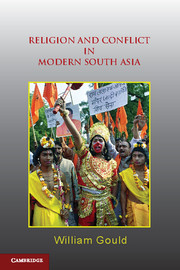Book contents
- Frontmatter
- Contents
- Abbreviations
- Glossary
- Acknowledgements
- 1 Introduction
- 2 Building Spheres of Community
- 3 Transforming Spheres of Community
- 4 Defining Spheres of Community
- 5 State Transformation, Democracy and Conflict
- 6 Forging National Consensus and Containing Pluralism
- 7 New Conflicts and Old Rivalries
- 8 The Resurgence of Communalism?
- Conclusion
- Bibliography
- Index
6 - Forging National Consensus and Containing Pluralism
South Asian States between 1947 and 1967
Published online by Cambridge University Press: 05 June 2012
- Frontmatter
- Contents
- Abbreviations
- Glossary
- Acknowledgements
- 1 Introduction
- 2 Building Spheres of Community
- 3 Transforming Spheres of Community
- 4 Defining Spheres of Community
- 5 State Transformation, Democracy and Conflict
- 6 Forging National Consensus and Containing Pluralism
- 7 New Conflicts and Old Rivalries
- 8 The Resurgence of Communalism?
- Conclusion
- Bibliography
- Index
Summary
The dramatic events of India’s partition in 1947 accompanied the carving up of old British India and presaged what was to become one of the world’s most bitter and intractable international conflicts. This chapter will look at how this history, and the end of colonial power in South Asia, transformed the nature of religious and ethnic conflict. Public and media discussions of ‘communalism’ and its attendant violence were not suddenly different after 1947, but the terms of debate and discussion certainly shifted. Now, most Indians and Pakistanis were theoretically defined by the state as ‘citizens’ rather than ‘subjects’. Rights were defined by democratic conventions and (rapidly in the case of India) a written constitution. This was a gradual process, not least because the basic frameworks of the administration and police remained as in the late colonial period. But now, the electoral politics that was beginning to develop through provincial autonomy from the late 1930s became a reality for all Indians. Local political rivalries had already mapped onto existing state structures, and one of the weapons in factional conflict was accusations of ‘communal’ partisanship. A similar situation evolved in Ceylon (to become Sri Lanka in 1972) from 1948 under the United National Party, which dominated the island until 1956, although here, as we will see, tension between different ethnic communities became more pronounced. In Pakistan, power was more centralised, and the legislatures had much less authority. The domination of Punjabis and migrants from UP in Pakistan also created specific, cross-cutting ethnic tensions that went to the root of state power. Based on an entirely different idea of national identity, Pakistan’s ethnic and religious conflicts were not analysed by observers in terms of a fragile ‘secularism’ as in India.
Communalism, ethnic conflict and sectarianism in both India and Pakistan often related to the specific nature of the relationship between the two states. First, the experiences of partition violence became a frame of reference for future conflict, even if sometimes only in a symbolic way. This created uncertainty not only for Hindu minorities in Pakistan, most of whom eventually opted for India, but also for many Indian Muslims who were forced to move, in the first instance, to Pakistan, but then took the option to return and found that their status as ‘Indian’ citizens was ambiguous. The position of many Muslims in India was now quite fragile. Formally, the partition had helped to justify the establishment of a secular state in India: the country’s accommodation of all religious communities with full citizenship rights acted as a theoretical counterpoise to the idea of ‘Pakistan’, as we saw in the . However, the essential fragility of secularism in India quickly exposed Nehruvian rhetoric as an unstable representation of Indian realities. First, the memories of 1947 had helped conservatives to limit the pace of social reform. This was evident, for example, in the watering down of the Hindu Code Bill, which aimed to empower women in matters of inheritance and divorce. Second, tension and war between India and Pakistan completely transformed the position of Muslims in India and Hindus in Pakistan. In India, though the secular constitution protected the interests and rights of minorities, Muslims, particularly government servants and policemen, were immediately placed under suspicion if they joined religious movements or parties. Most famously, Vallabhbhai Patel, India’s first Home Minister, made it clear that Muslims in India would have to ‘prove’ their loyalty. Third, following independence, the ambiguities of national identity for India’s Muslims were reinforced by India’s forced integration of Hyderabad and Junagadh and the war created over Kashmir. And the centralising tendencies of governments over this period presupposed a majoritarian Indian identity that did not sit comfortably with other regional/ethnic identities. Finally, and perhaps most importantly of all, the letter of constitutional rights set out in 1950 did not prevent the continued reference to religious community in everyday political mobilisation – a situation that, by the early 1980s, allowed parties of the Hindu right to re-enter more forcefully the political frame in key regions across India.
- Type
- Chapter
- Information
- Religion and Conflict in Modern South Asia , pp. 195 - 231Publisher: Cambridge University PressPrint publication year: 2011



